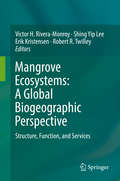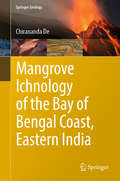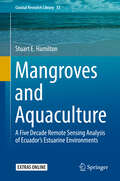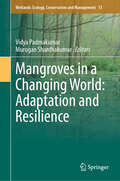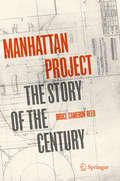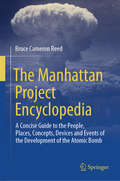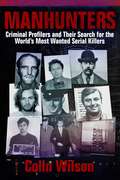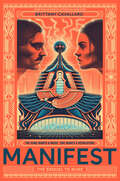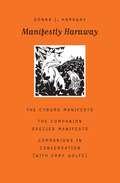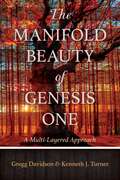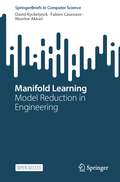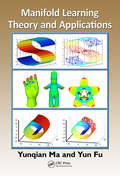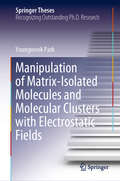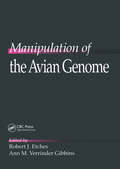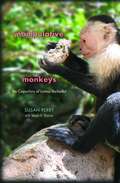- Table View
- List View
Mangrove Ecosystems: A Global Biogeographic Perspective
by Victor H. Rivera-Monroy Shing Yip Lee Erik Kristensen Robert R. TwilleyThis book presents a comprehensive overview and analysis of mangrove ecological processes, structure, and function at the local, biogeographic, and global scales and how these properties interact to provide key ecosystem services to society. The analysis is based on an international collaborative effort that focuses on regions and countries holding the largest mangrove resources and encompasses the major biogeographic and socio-economic settings of mangrove distribution. Given the economic and ecological importance of mangrove wetlands at the global scale, the chapters aim to integrate ecological and socio-economic perspectives on mangrove function and management using a system-level hierarchical analysis framework. The book explores the nexus between mangrove ecology and the capacity for ecosystem services, with an emphasis on thresholds, multiple stressors, and local conditions that determine this capacity. The interdisciplinary approach and illustrative study cases included in the book will provide valuable resources in data, information, and knowledge about the current status of one of the most productive coastal ecosystem in the world.
Mangrove Ecosystems of Asia
by I. Faridah-Hanum A. Latiff Khalid Rehman Hakeem Munir OzturkThe book provides an up-to-date account of mangrove forests from Asia, together with restoration techniques, and the management requirements of these ecosystems to ensure their sustainability and conservation. All aspects of mangroves and their conservation are critically re-examined. The book is divided into three sections presenting the distribution and status of mangrove ecosystems in Asia, the challenges they are facing, their issues and opportunities, and the management strategies for their conservation.
Mangrove Forests in India: Exploring Ecosystem Services
by Abhijit MitraThis is the first comprehensive science-based primer to highlight the unique ecosystem services provided by mangrove forests, and discuss how these services preserve the livelihoods of coastal populations. The book presents three decades of real-time data on Sundarbans and Bhitarkanika mangroves in India measuring carbon and nitrogen sequestration, as well as case studies that demonstrate the utility provided by mangroves for reducing the impact of storms and erosion, providing nutrient retention for complex habitats, and housing a vast reservoir of plant, animal and microbial biodiversity. Also addressed is the function of mangroves as natural ecosystems of cultural convergence, offering the resources and products necessary for thriving coastal communities. The book will be of interest to students, academics and researchers in the fields of oceanography, marine biology, botany, climate science, ecology and environmental geography, as well as consultants and policy makers working in coastal zone management and coastal biodiversity conservation.
Mangrove Ichnology of the Bay of Bengal Coast, Eastern India (Springer Geology)
by Chirananda DeThis book focuses on the world’s largest mangrove delta complex, located at Sundarban, a world heritage site, and on the relatively new and rapidly expanding scientific discipline of ichnology. In addition to presenting a range of ichnological research databases that are widely applicable to multidisciplinary research fields in geology, biophysics, biology, ecology, geomorphology and the marine and environmental sciences, it addresses the global concern of rising sea levels to explain growing ecological problems, from the mass mortality of coastal organisms and rapid loss of mangrove forest wealth, to widespread coastal and riverbank erosion. It also demonstrates the value of applying new ichnological tools to coastal geotechnical planning and programming, and to groundwater exploration. Thus, the book addresses a broad readership including earth scientists from various disciplines, state administrators and members of the general public.
Mangrove Microbiome: Diversity and Bioprospecting
by Sanjivkumar Muthusamy Radhakrishnan Manikkam Gopikrishnan VenugopalThis book highlights the diversity, and industrial and bio-therapeutic applications of mangrove associated microbiomes. The bioactive metabolites from the mangrove microbiomes show high antimicrobial, antioxidant, anti-inflammatory, anticancer, antidiabetic and anti-biofilm activities. Their environmentally significant capabilities such as remediation, degradation and agriculture enhancing properties are discussed in this book as well. Mangroves are extremely nutrient-rich and productive ecosystems found adjacent to coastal waters and they stand at the base of an extensive food web. Diverse groups of metabolically active microbial populations of this ecosystem produce economically important bio-active metabolites which have environmental, cosmetic, food and biomedical industrial applications. This book aims to consolidate the research, bridge the knowledge gaps, and stimulate further research on mangrove microbiomes. It provides a valuable resource that benefits the scientific community, academic researchers, healthcare practitioners, and individuals interested in the potential use of microbial populations of mangrove ecosystem in managing bio-efficiencies.
The Mangrove Tree: Planting Trees to Feed Families
by Susan L. Roth Cindy TrumboreThe fascinating story of Dr. Gordon Sato, who helped a small African village become self-sustaining by planting a forest of mangrove trees to reshape the community's ecosystem.For a long time, the people of Hargigo, a village in the tiny African country of Eritrea, were living without enough food for themselves and their animals. The families were hungry, and their goats and sheep were hungry too. Then along came a scientist, Dr. Gordon Sato, who helped change their lives for the better. And it all started with some special trees. These are the trees, Mangrove trees, That were planted by the sea. With alternating verse and prose passages, The Mangrove Tree invites readers to discover how Dr. Sato's mangrove tree-planting project transformed an impoverished village into a self-sufficient community. This fascinating story is a celebration of creativity, hard work-and all those mangrove trees that were planted by the sea!
Mangroves and Aquaculture: A Five Decade Remote Sensing Analysis of Ecuador’s Estuarine Environments (Coastal Research Library #33)
by Stuart E. HamiltonThis book uses five decades of map data, air photos, and medium to high-resolution satellite imagery to track the expansions of aquaculture and the loss of both estuarine and mangrove land covers in Ecuador. The results are staggering. In some regions, Ecuador has lost almost 50% of its estuarine space and approximately 80% of its mangrove forest. The current estuarine land cover bears no resemblance to the historic estuarine land cover. The analysis is complete from 1968 to 2014. The analysis covers all the major estuaries of mainland Ecuador. The research expands beyond purely land cover into the land use of the estuaries and the implications of the land cover transitions. The author lived in Ecuador's estuarine environments for almost two years studying this area. During this time he conducted mapping workshops with local residents, conducted 100 interviews with local actors, conducted six group discussions with fisherfolk syndicates, conducted eight presentations, worked on a shrimp farm. He was employed by the Ministry of the Environment on a Prometeo fellowship for one-year researching estuarine health and worked on mangrove replanting projects in the estuaries. In addition to the remote sensing data, the author provides a contextual framework to the analysis. It is not just hard numbers that are presented, but a remote sensing analysis tied to local actors that tell a coherent almost 50 -year estuarine story at the national, provincial, and local scales The book is intended for researchers, academics, graduate students, NGOs, and government actors including those who work in development, environment, and policy implementation. It is suitable supplemental reading for students in courses related to the coastal zone, land use change, and remote sensing. The electronically supplementary material includes all the related data to underpin the analysis as well as all the resulting GIS files.
Mangroves: Biodiversity, Livelihoods and Conservation
by Sudhir Chandra Das Pullaiah Thammineni Elizabeth C. AshtonThis contributory volume is a comprehensive collection on the mangrove forest eco-system and its ecology, the resources and potentials of mangroves, conservation efforts, mangrove eco-system services and threats to conservation. The book is an all-inclusive compilation on the status, conservation and future of mangroves. Mangroves are a unique ecosystem providing several ecosystem services. They are formed in the inter-tidal areas of large rivers and coastal islands. Mangroves thrives due to constant interaction with the terrestrial and marine ecosystem. These are the species dynamics, varying tidal amplitudes, plant succession, changing floral pattern of the channels of the estuary, the varying sediment transportation. There was 20% decline in mangrove forest area in the last 25 years due mainly to conversion and coastal development. Lengthy recovery periods required for the degraded mangrove forests. Hence there is an urgent need to take stock of the updated information on these mangroves at global level. It is of immense value to scientific community involved in teaching, research and extension activities related to mangrove conservation.
Mangroves: Ecology, Biodiversity and Management
by Rajesh P. Rastogi Mahendra Phulwaria Dharmendra K. GuptaMangroves are one of the most productive and biologically important blue-carbon ecosystems across the coastal intertidal zone of earth. In the current scenario of serious environmental changes like global warming, climate change, extreme natural disasters, mangrove forests play a vital role in mitigating greenhouse gas emissions and maintaining ecosystem balance. Mangroves are unique ecosystems with rich biological diversity of different taxonomic groups exhibiting great ecological and commercial importance. The book consolidates existing and emerging information on ecology of mangroves, with a special reference to their biodiversity and management. It emphasizes on the role of mangroves in providing various ecological services. The book is a comprehensive compilation covering all aspects of mangrove ecology. It is useful for students and researchers in ecology, plants sciences and environmental sciences.
Mangroves in a Changing World: Adaptation and Resilience (Wetlands: Ecology, Conservation and Management #13)
by Vidya Padmakumar Murugan ShanthakumarMangroves are among the most productive and diverse ecosystems on Earth, providing a range of ecosystem services that benefit millions of people and support global sustainability goals. However, mangroves are also highly vulnerable to climate change impacts, such as sea level rise, storms, salinity changes, and erosion, which threaten their survival and functionality. This book aims to provide researchers with the latest scientific knowledge and practical tools to understand, assess, and enhance the adaptation and resilience of mangroves to climate change. It covers topics such as mangrove ecology and distribution, mangrove ecosystem services and valuation, mangrove adaptation and resilience mechanisms and indicators, mangrove restoration and conservation strategies, mangrove governance and policy frameworks, and mangrove modelling and mapping approaches. The book also showcases case studies from different regions of the world, highlighting the challenges and opportunities of mangrove management in a changing world. The book is intended to serve as a valuable reference and resource for researchers, students, practitioners, policymakers, and anyone interested in mangrove science and management.
Manhattan Project: The Story of the Century (Iop Concise Physics Ser.)
by Bruce Cameron ReedThough thousands of articles and books have been published on various aspects of the Manhattan Project, this book is the first comprehensive single-volume history prepared by a specialist for curious readers without a scientific background. This project, the United States Army’s program to develop and deploy atomic weapons in World War II, was a pivotal event in human history. The author presents a wide-ranging survey that not only tells the story of how the project was organized and carried out, but also introduces the leading personalities involved and features simplified but accurate descriptions of the underlying science and the engineering challenges. The technical points are illustrated by reader-friendly graphics. .
The Manhattan Project Encyclopedia: A Concise Guide to the People, Places, Concepts, Devices and Events of the Development of the Atomic Bomb
by Bruce Cameron ReedThis book provides a guide to the people, places, artifacts, events, terminology, scientific concepts, groups, critical documents, and code phrases associated with the Manhattan Project. It is of interest to all readers/researchers (students, journalists, policy-makers, specialist and non-specialist instructors and scientists) who need to rapidly access authoritative, self-contained definitions/descriptions of such items and references to authoritative sources. The individual entries are extensively cross-referenced.
Manhunters: Criminal Profilers and Their Search for the World?s Most Wanted Serial Killers
by Colin WilsonAuthor Colin Wilson opens this illuminating psychological discussion with the development of the 1977 Behavioral Science Unit, which was set up in order to answer the many questions surrounding serial killers: How does someone become a serial killer? How do they choose their victims, and why do they not feel remorse? How are they caught? Wilson interviews FBI Special Agent Robert Ressler, coiner of the term "serial killer" and one of the pioneers of criminal profiling, as well as Ted Bundy and Charles Manson in order to figure out the motives behind their grisly actions.In Manhunters, by tracking the BSU's development of psychological profiling and genetic fingerprinting, Wilson reveals the forensic investigations that caused the seizure and arrest of some of the most vile and villainous people in the world, including Jeffrey Dahmer, William Heirens, Peter Sutcliffe, John Duffy, Jerry Brudos, Wayne Williams, and many more. As he divulges the details of each case, the murderers' fantasy worlds, sadistic motives, and monstrous psychological tendencies emerge.
Manifest
by Brittany CavallaroNew York Times bestselling author Brittany Cavallaro delivers the thrilling conclusion to her YA duology set in a reimagined American monarchy about a girl fighting for her own freedom, trying to change the government from within . . . or burn it all down.For the first time in her life, Claire Emerson isn’t under a man’s control. She’s escaped from her dangerous father, and her fiancé, Governor Remy Duchamp, is too weak to rule. All eyes fall on Claire—and the power she could wield.But that power is precarious as she and Remy are leading St. Cloud in exile after the General’s attempted coup. And when King Washington descends on the small province, he brings with him his baseball team, Claire’s brother, and a proximity to power Claire has never dreamed of. With few allies to support her, she determines her best chance at survival is earning the King’s good graces. Claire’s schemes quickly get out of hand, reminding her that it isn’t about who holds the power. It’s about a system that grants such power to a select few, and the men who built it that way. Claire isn’t anyone’s muse, and if she can’t fix the system from within, she’s determined to be the spark of revolution in the First American Kingdom.
Manifestly Haraway (Posthumanities #37)
by Donna J. HarawayElectrifying, provocative, and controversial when first published thirty years ago, Donna Haraway&’s &“Cyborg Manifesto&” is even more relevant today, when the divisions that she so eloquently challenges—of human and machine but also of gender, class, race, ethnicity, sexuality, and location—are increasingly complex. The subsequent &“Companion Species Manifesto,&” which further questions the human–nonhuman disjunction, is no less urgently needed in our time of environmental crisis and profound polarization.Manifestly Haraway brings together these momentous manifestos to expose the continuity and ramifying force of Haraway&’s thought, whose significance emerges with engaging immediacy in a sustained conversation between the author and her long-term friend and colleague Cary Wolfe. Reading cyborgs and companion species through and with each other, Haraway and Wolfe join in a wide-ranging exchange on the history and meaning of the manifestos in the context of biopolitics, feminism, Marxism, human–nonhuman relationships, making kin, literary tropes, material semiotics, the negative way of knowing, secular Catholicism, and more.The conversation ends by revealing the early stages of Haraway&’s &“Chthulucene Manifesto,&” in tension with the teleologies of the doleful Anthropocene and the exterminationist Capitalocene. Deeply dedicated to a diverse and robust earthly flourishing, Manifestly Haraway promises to reignite needed discussion in and out of the academy about biologies, technologies, histories, and still possible futures.
The Manifold Beauty of Genesis One: A Multi-Layered Approach
by Gregg Davidson Kenneth J. TurnerSee and celebrate the multilayered grandeur conveyed by the first chapter of GenesisThe first chapter of the Bible's first book lays the foundation for all that follows about who God is and what God is like. Our technology-age fascination with the science of origins, however, can blind us to issues of great importance that don't address our culturally conditioned questions. Instead, Genesis One itself suggests the questions and answers that are most significant to human faith and flourishing. Geologist Gregg Davidson and theologian Ken Turner shine a spotlight on Genesis One as theologically rich literature first and foremost, exploring the layers of meaning that showcase various aspects of God's character:• Song• Analogy• Polemic• Covenant• Temple• Calendar• LandOur very knowledge of God suffers when we fail to appreciate the Bible's ability to convey multilayered truth simultaneously. The Manifold Beauty of Genesis One offers readers the chance to cultivate an openness to Scripture's richness and a deeper faith in the Creator.
Manifold Learning: Model Reduction in Engineering (SpringerBriefs in Computer Science)
by David Ryckelynck Fabien Casenave Nissrine AkkariThis Open Access book reviews recent theoretical and numerical developments in nonlinear model order reduction in continuum mechanics, being addressed to Master and PhD students, as well as to researchers, lecturers and instructors. The aim of the authors is to provide tools for a better understanding and implement reduced order models by using: physics-based models, synthetic data forecast by these models, experimental data and deep learning algorithms. The book involves a survey of key methods of model order reduction applied to model-based engineering and digital twining, by learning linear or nonlinear latent spaces.Projection-based reduced order models are the projection of mechanical equations on a latent space that have been learnt from both synthetic data and experimental data. Various descriptions and representations of structured data for model reduction are presented in the applications and survey chapters. Image-based digital twins are developed in a reduced setting. Reduced order models of as-manufactured components predict the mechanical effects of shape variations. A similar workflow is extended to multiphysics or coupled problems, with high dimensional input fields. Practical techniques are proposed for data augmentation and also for hyper-reduction, which is a key point to speed up projection-based model order reduction of finite element models.The book gives access to python libraries available on gitlab.com, which have been developed as part of the research program [FUI-25] MORDICUS funded by the French government. Similarly to deep learning for computer vision, deep learning for model order reduction circumvents the need to design parametric problems prior reducing models. Such an approach is highly relevant for image-base modelling or multiphysics modelling.
Manifold Learning Theory and Applications
by Yunqian Ma Yun FuTrained to extract actionable information from large volumes of high-dimensional data, engineers and scientists often have trouble isolating meaningful low-dimensional structures hidden in their high-dimensional observations. Manifold learning, a groundbreaking technique designed to tackle these issues of dimensionality reduction, finds widespread
Manipulation and Characterization of Electrosprayed Ions Under Ambient Conditions
by Zane BairdThis thesis addresses the evolving field of measurement science, specifically that of mass spectrometry (MS) and ion mobility spectrometry (IMS) based techniques. It focuses on the design, construction and implementation of low-cost, easy-to-manufacture measurement tools that are used in modern settings such as airport security screening. Advances in these technologies often involve minimal performance enhancement at ever-increasing cost, which in turn limits accessibility to versatile measurement tools. This problem is addressed using hobbyest 3D printers along with widely available materials for the production of novel ion lenses and an IMS instrument with a performance comparable to that of many commercial systems. Baird#65533;s findings are of relevance to analytical chemistry and a source of inspiration for scientists exploring this emerging field.
Manipulation of Matrix-Isolated Molecules and Molecular Clusters with Electrostatic Fields (Springer Theses)
by Youngwook ParkThis book describes the manipulation of molecular properties, such as orientation, structure, and dynamics, of small molecules and molecular clusters isolated in cold inert matrices by using unprecedentedly strong external electrostatic fields. Manipulation of molecules with controllable external forces is a dream of chemists. Molecules are inherently quantum-mechanical systems, control of which potentially can lead to quantum technology, such as quantum sensing and computing. This book demonstrates a combination of the ice film nanocapacitor method and the matrix isolation technique enabled the application of intense external dc electric fields across the isolated molecules and molecular clusters. Changes in molecular states induced by fields were monitored by means of vibrational spectroscopy. Also, the book presents manipulations of the inversion tunneling dynamics of ammonia molecule and the dislocation of acidic proton in hydrogen chloride–water complex. The book shows that the vibrational spectroscopy with the aid of unprecedentedly strong dc electric field can provide rich information on the electrostatic behaviors of molecules and molecular clusters, which underlie the understanding of intermolecular processes and molecular manipulation.
Manipulation of Multiphase Materials for Touch-less Nanobiotechnology
by Sara CoppolaThe thesis presents an original and smart way to manipulate liquid and polymeric materials using a "pyro-fluidic platform" which exploits the pyro-electric effect activated onto a ferroelectric crystal. It describes a great variety of functionalities of the pyro-electrohydrodynamic platform, such as droplet self-assembling and dispensing, for manipulating multiphase liquids at the micro- and nanoscale. The thesis demonstrates the feasibility of non-contact self-assembling of liquids in plane (1D) using a micro engineered crystal, improving the dispensing capability and the smart transfer of material between two different planes (2D) and controlling and fabricating three-dimensional structures (3D). The thesis present the fabrication of highly integrated and automated 'lab-on-a-chip' systems based on microfluidics. The pyro-platform presented herein offers the great advantage of enabling the actuation of liquids in contact with a polar dielectric crystal through an electrode-less configuration. The simplicity and flexibility of the method for fabricating 3D polymer microstructures shows the great potential of the pyro-platform functionalities, exploitable in many fields, from optics to biosensing. In particular, this thesis reports the fabrication of optically active elements, such as nanodroplets, microlenses and microstructures, which have many potential applications in photonics. The capability for manipulating the samples of interest in a touch-less modality is very attractive for biological and chemical assays. Besides controlling cell growth and fate, smart micro-elements could deliver optical stimuli from and to cells monitoring their growth in real time, opening interesting perspectives for the realization of optically active scaffolds made of nanoengineered functional elements, thus paving the way to fascinating Optogenesis Studies.
Manipulation of the Avian Genome
by Robert J. Etches Ann M. GibbinsMany genes have been cloned from chicken cells, and during the next decade numerous laboratories will be concentrating their resources in developing ways of using these tools. Manipulation of the Avian Genome contains the most recent information from leading research laboratories in the areas of developmental and molecular genetics of the chicken. This information was presented at the Keystone Symposium held at Lake Tahoe in March, 1991. The book discusses potential applications of emerging technology in basic science and poultry production. Various techniques for altering genomic DNA, such as microinjection, retroviral vectors, and lipofection are covered. Genome evaluation using DNA fingerprinting and conventional breeding techniques are presented.
Manipulation von Abgaswerten: Technische, gesundheitliche, rechtliche und politische Hintergründe des Abgasskandals
by Kai BorgeestDieses kleine Buch stellt Hintergründe zum Abgasskandal dar, z. B. welche Schadstoffe kritisch sind, wie Motorsteuergeräte, Abgasrückführung und Abgasnachbehandlung funktionieren, wie Manipulationen auf dem Prüfstand möglich sind, mit welchen Fahrzyklen getestet wird und in welchem rechtlichen und politischen Umfeld dies lange Zeit unbemerkt mit unterschiedlichen Konsequenzen in der EU und den USA geschehen konnte. Es werden Maßnahmen vorgestellt, mit denen Fahrzeuge auch real gesetzliche Grenzwerte einhalten können und wie Manipulationen zukünftig rechtlich und politisch verhindert werden können. Dem Leser werden durch Literaturhinweise zusätzliche Details erschlossen.
Manipulation von Abgaswerten: Technische, gesundheitliche, rechtliche und politische Hintergründe des Abgasskandals
by Kai BorgeestDieses kleine Buch stellt Hintergründe zum Abgasskandal dar, z. B. welche Schadstoffe kritisch sind, wie Motorsteuergeräte, Abgasrückführung und Abgasnachbehandlung funktionieren, wie Manipulationen auf dem Prüfstand möglich sind, mit welchen Fahrzyklen getestet wird und in welchem rechtlichen und politischen Umfeld dies lange Zeit unbemerkt mit unterschiedlichen Konsequenzen in der EU und den USA geschehen konnte. Es werden Maßnahmen vorgestellt, mit denen Fahrzeuge auch real gesetzliche Grenzwerte einhalten können und wie Manipulationen zukünftig rechtlich und politisch verhindert werden können. Dem Leser werden durch Literaturhinweise zusätzliche Details erschlossen.
Manipulative Monkeys: The Capuchins of Lomas Barbudal
by Susan PerryThe authors describe is behavior as entertaining--and occasionally as alarming--as it is recognizable: the competition and cooperation, the jockeying for position and status, the peaceful years under an alpha male devolving into bloody chaos, and the complex traditions passed from one generation to the next. <P><P>Interspersed with their observations of the monkeys' lives are the authors' colorful tales of the challenges of tropical fieldwork--a mixture so rich that by the book's end we know what it is to be a wild capuchin monkey or a field primatologist.
